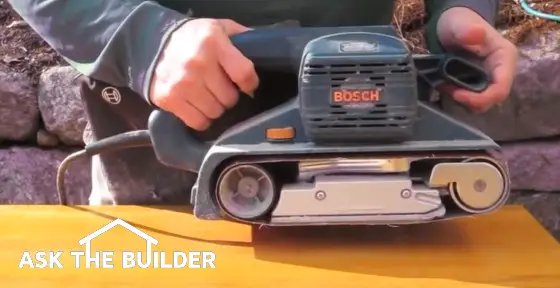Belt Sanding Tips

This is a durable belt sander that’s easy to use and quickly sands large surfaces. Photo Credit: Tim Carter
Belt Sander
Quick Column Summary:
- Using a belt sander
- Uses for other than sanding
- Restore many wood projects
DEAR TIM: I was in a home center and saw a hand-held belt sander. It seems so much more useful than the smaller oscillating sanders. I’m really thinking of getting one. What can you tell me about them and is it too much tool for the average homeowner? What kind of things can I use it on? What are the dangers? Peggy K., Columbus, OH
DEAR PEGGY: Welcome to the world of amazing and useful power tools! You’re going to thank your lucky stars that you went down that aisle at the home center. If I was stranded on a desert island that had electricity, running water, Internet service, hammocks and workbenches in the shade, etc. a belt sander would be in my top ten list of power tools to have with me.
In all seriousness, I’ve used belt sanders for decades and I can’t begin to tell you how useful they are. It’s one of those tools that seems to have endless uses.
For example, years ago when I was a young carpenter, we’d use wood chisels in rough carpentry for any number of tasks. A woodworker would shudder to see how we abused these tools. A belt sander was a fantastic way to sharpen the chisels in just seconds. We’d use low-quality chisels for this type of work, so it didn’t matter if you didn’t have a perfect edge on the chisel. I’m just sharing this story to demonstrate the wide assortment of tasks, other than sanding wood, that a belt sander can do quite well.
Belt sanders come in several sizes. You’ll discover quickly that there’s two common belt width sizes: 3-inch and 4-inch. The length of the belt is the other measurement. It can range from 18 inches up to 24 inches for the common hand-held belt sanders. Stationary or bench-mounted belt sanders come in much different sizes. Don’t confuse the two machines.
As you might expect, the sanders accept sandpaper of many different grits. You can purchase very coarse grit to quickly cut down rough surfaces. In seconds you can switch out the sanding belt and have the sander ready to operate with a very fine grit paper that will make the wood surface satin smooth.
I don’t think a belt sander is too much tool. It doesn’t take much practice to be able to use one effectively. A belt sander is not dangerous like a circular saw or any other saw that has a sharp blade that can cut you. The only thing that might get damaged is the piece of wood or furniture you’re working on. That’s why you want to practice using a belt sander first on a piece of scrap lumber.
You can use a belt sander to smooth a worn wood deck. If you do this, be sure to countersink any and all nails or screws. Anything metal can destroy a sanding belt in seconds should the sander contact it. Years ago we didn’t ruin the sanding belts with our wood chisels because we positioned the chisel at a very low angle and the belt was moving away from the cutting edge of the chisel.
I routinely use my belt sander to do the fine adjustments to a scribed line. Filler strips for cabinets, extension wings on fine custom cabinets, baseboard, crown molding, etc. often need to be scribed to an uneven surface. A belt sander allows you to slowly and methodically work up and kiss that scribed line. It’s carpentry magic as far as I’m concerned.
You’ll discover your belt sander can help you restore a worn wood picnic table. Imagine using one to sand a small section of hardwood floor that’s put in a tiny room. The sander is great for sanding any flat surface in a jiffy. Just put your thinking cap on.
Using a belt sander is not hard. Many pros will tell you to move the sander around both front and back and sideways when it’s on. If you don’t, the sander can dig a hole just sanding away in one stationary position. That’s usually not a good thing.
I’ve discovered that you don’t have to put much downward pressure on a belt sander for it to be effective. The weight of the tool is often all it needs. You’ll discover the grit on the sanding belts is what makes the job go fast.
If you want to watch a video of me using a belt sander, just go to this page of my website. Watch how I move the sander around in an oval as I cut through the varnish finish. - Belt Sanding Tips Video
Column 1028
One Response to Belt Sanding Tips